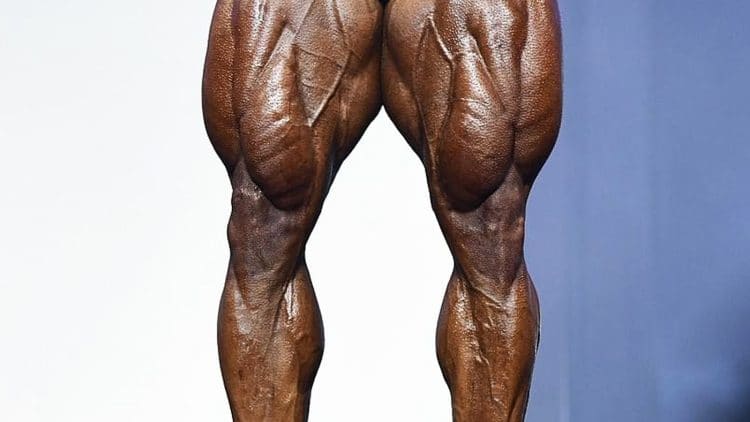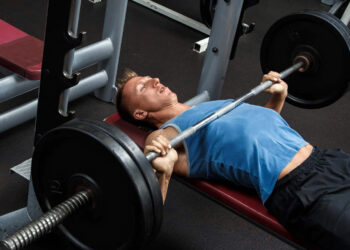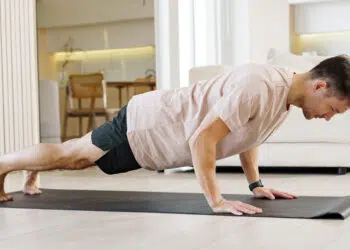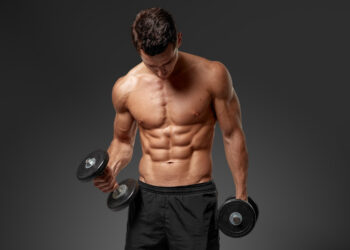There is no denying the effectiveness of gym-based workouts for building muscle and strength. Freeweights and resistance training machines are one of the most convenient ways to overload your muscles and sculpt the body of your dreams.
But, not everyone wants to lock themselves away in an air-conditioned room for several hours per week, especially during the summer. You may even prefer to train outside the gym, for example, in your home or garage.
Bodyweight exercises are an excellent non-gym training option, and you can do them anywhere and anytime.
However, unless you are prepared to spend time learning and mastering things like planch push-ups, muscle-ups, and pistol squats, you will probably be limited to a handful of basic exercises, which will soon become boring.
But, before you write off bodyweight training as being ineffectual, it’s worth mentioning that there is a way to expand your calisthenic workout library without having to become a gymnast.
We’re talking about suspension training.
Level Up Your Fitness: Join our 💪 strong community in Fitness Volt Newsletter. Get daily inspiration, expert-backed workouts, nutrition tips, the latest in strength sports, and the support you need to reach your goals. Subscribe for free!
Suspension trainers like the TRX and suspended rings are one of the best ways to make bodyweight training more effective. Plus, using a suspension trainer means that you can replicate many freeweight and machine exercises using just your body weight.
Lengthen or shorten the straps or move your feet to change the angle of your body and the difficulty of your workout. Suspension training is as easy or as hard as you need it to be – just like working with freeweights or resistance machines.
All you need is a suspension training device and somewhere to hang it.
So, for this article, we’re going to provide you with a four-way split bodybuilding training program built around suspension training. Armed with your TRX device or similar, you can work out anywhere and anytime and build muscle mass without weights.
Suspension Trainer Workout Plan – Overview
This suspension trainer bodybuilding workout hits all your major muscles once per week using a four-way split. That means you’ll be training on four separate days.
But, as it’s a bodybuilding program, and bodybuilders LOVE to train their arms, you’ll actually get to work your biceps and triceps twice a week.
So, your weekly schedule looks like this:
| Monday | Tuesday | Wednesday | Thursday | Friday | Saturday | Sunday |
| Chest & Triceps | Back & Biceps | Rest | Legs & Abs | Rest | Shoulders & Arms | Rest |
Feel free to move the workouts if you need to but try to keep them in the same order. The workouts have been programmed to avoid overlaps and provide plenty of time for rest and recovery.
For example, it would be a mistake to train your shoulders the day after hitting your chest, as these training days involve many of the same muscles.
Here are your four workouts:
Workout 1 – Chest and Triceps
| # | Exercise | Sets | Reps | Recovery |
| 1 | Chest Eccentric Fly | 3 | 8-15 | 60-90 seconds |
| 2 | Chest Press | 3 | 8-15 | 60-90 seconds |
| 3 | Push-up/Fly Combo | 3 | 8-15 | 60-90 seconds |
| 4 | Atomic Push-up | 3 | 8-15 | 60-90 seconds |
| 5 | Triceps Extension | 3 | 8-15 | 60-90 seconds |
| 6 | Triceps Dip | 3 | 8-15 | 60-90 seconds |
Workout 2 – Back and Biceps
| # | Exercise | Sets | Reps | Recovery |
| 1 | Pull-up | 3 | 8-15 | 60-90 seconds |
| 2 | Single-arm Row | 3 | 8-15 | 60-90 seconds |
| 3 | Inverted Row | 3 | 8-15 | 60-90 seconds |
| 4 | Face Pull | 3 | 8-15 | 60-90 seconds |
| 5 | Hercules Curl | 3 | 8-15 | 60-90 seconds |
| 6 | Biceps Curl | 3 | 8-15 | 60-90 seconds |
Workout 3 – Legs and Abs
| # | Exercise | Sets | Reps | Recovery |
| 1 | Pistol Squat | 3 | 8-15 | 60-90 seconds |
| 2 | Split Squat | 3 | 8-15 | 60-90 seconds |
| 3 | Sissy Squat | 3 | 8-15 | 60-90 seconds |
| 4 | Curl Bridge | 3 | 8-15 | 60-90 seconds |
| 5 | Body Saw | 3 | 8-15 | 60-90 seconds |
| 6 | Oblique Crunch | 3 | 8-15 | 60-90 seconds |
Workout 4 – Shoulders and Arms
| # | Exercise | Sets | Reps | Recovery |
| 1 | Pike Push-up | 3 | 8-15 | 60-90 seconds |
| 2 | Squat Y Row | 3 | 8-15 | 60-90 seconds |
| 3 | Rear Delt Fly | 3 | 8-15 | 60-90 seconds |
| 4 | Triceps Kickback | 3 | 8-15 | 60-90 seconds |
| 5 | Chest Hug | 3 | 8-15 | 60-90 seconds |
Of course, before you begin any workout, you need to spend a few minutes warming up and preparing your body for what you’re about to do. This will not only make your training more productive, but could lower your risk of injury, too.
So, start with a few minutes of easy cardio followed by some dynamic mobility and flexibility exercises for the muscles you’re going to train. Finish your warm-up with a couple of light sets of the first exercise of the workout you are about to do to ensure that you are 100% ready to go.
Suspension Trainer Workout Plan Exercise Instructions
There are two ways to do any exercise – the right way and the wrong way. The right way is safe and effective, while the wrong way isn’t! So, when in doubt, use less weight, focus on your technique, and remember that injuries are often avoidable if you train with good form and an appropriate level of resistance.
Remember to adjust the length of the straps of your suspension trainer to determine the difficulty of each exercise. Ideally, you should reach muscular failure within the specified 8-15 rep range.
Workout 1 – Chest and Triceps

1. Chest Eccentric Fly
You are 20 to 30-percent stronger eccentrically than you are concentrically. More simply put, you can lower more weight than you can lift. This exercise makes the most of this phenomenon to really hit your pecs hard.
How to do it:
- Adjust your suspension trainer so that the handles are about hip height. Hold the handles and adopt the push-up position with your arms straight and core braced.
- Open your arms and lower your chest down toward the floor. Get a good stretch at the bottom of your rep but take care not to hyperextend your shoulders.
- Bring your hands in, and then push yourself back up to the starting position.
- Repeat until you are no longer able to control your descent.
2. Chest Press
The chest press is a classic suspension trainer exercise. Having already fatigued your muscles eccentrically, this exercise should provide a good challenge for your pecs and produce a deep burn and powerful pump.
How to do it:
- Adjust your suspension trainer so that the handles are about hip height. Hold the handles and adopt the push-up position with your arms straight and core braced.
- Bend your arms and lower your chest down between your hands. Make sure you keep your body straight.
- Extend your arms and return to the starting position.
3. Push-up/Fly Combo
This funky-looking exercise involves doing a push-up with one arm and a suspension trainer fly with the other to provide a uniquely challenging chest workout.
How to do it:
- Using one suspension trainer strap only, adjust the handle, so it’s a few inches above the floor.
- Adopt the push-up position with one hand on the floor and the other holding the handle.
- Bend your arm and lower your chest toward the floor as you push the suspension trainer handle out and away to the side.
- Return to the starting position and repeat.
- On completion of your set, rest for a moment and then switch arms.
4. Atomic Push-up
The atomic push-up is part chest exercise and part abs exercise. This is the last move for your chest, so make sure you don’t hold back and give it everything you’ve got!
How to do it:
- Adjust the straps, so the handles are around knee height. Adopt the push-up position with your feet in the handles. Brace your core and place your hands a little wider than shoulder-width apart.
- Bend your elbows and lower your chest to the floor.
- Extend your arms and then bend your legs and pull your knees into your chest.
- Extend your legs and then bend your arms again.
- Continue until your pecs or abs reach failure.
5. Triceps Extension
This suspension trainer exercise is basically a bodyweight skull crusher. However, with no barbell to come crashing down on your noggin, you can train your triceps to failure in complete safety. After all, skull crushers are so-called for a very good reason!
How to do it:
- Shorten your suspension straps to about waist height. Hold a handle in each hand with an overhand grip. Extend your arms out in front of you and lean into the handles. Your upper arms should be parallel with each other and the floor.
- Bend your elbows and lower your head between your hands. Get a good stretch in your triceps.
- Extend your arms and repeat.
- Your shoulders should remain relatively stationary throughout this exercise, and most of the movement should come from your elbows.
6. Triceps Dip
Dips work your chest and triceps, making them the perfect way to end this workout. Suspension trainer dips are significantly more challenging than bench and parallel bar dips. You’ll need to work extra hard to stop the handles swinging away from you, which will increase muscle activation.
How to do it:
- Adjust the strap on your suspension trainer to around hip height. Stand between the handles and hold them with a parallel, palms-in grip. Place your feet slightly in front of you and support your weight on your arms.
- Bend your elbows and descend until your upper arms are roughly parallel to the floor.
- Extend your arms and repeat.
- The further you place your feet out in front of you, the harder this exercise becomes, so adjust your feet accordingly.
Workout 2 – Back and Biceps

1. Pull-up
Pull-ups are a classic back-building exercise. Working your lats and lower traps, as well as your biceps, this move is one exercise you cannot afford to skip. Suspension trainer pull-ups are a little easier than regular pull-ups because your feet remain on the floor.
How to do it:
- Shorten the straps on your TRX so that, when you sit beneath the handles, you can just about reach them.
- Holding the handles and with your legs out straight in front of you, bend your arms and pull yourself up. Allow your wrists to rotate naturally.
- Extend your arms and repeat.
- Supercharge this exercise by keeping your legs straight and lifting them off the floor as you pull yourself up. This is called an L-pull-up.
2. Single-arm Row
A lot of people are surprised to learn that they can do single-arm exercises with a suspension trainer. All you need to do is thread one handle through the other to create a secure grip for one hand. This single-limb exercise is an excellent alternative to single-arm dumbbell rows. It will help identify and fix left-to-right strength and muscle size imbalances.
How to do it:
- Adjust the straps, so the handles are at waist height. Grip the handles in one hand and lean back, feet flat on the floor, and legs straight.
- Bend your arm and, without twisting your shoulders or your hips, pull yourself up to the handle. Extend your arm and repeat. Once you have completed all your reps, switch arms and do the same number of reps on the other.
- Make this exercise harder by extending the straps and leaning further back. Make it easier by shortening the straps and putting your body at a shallower angle.
Level Up Your Fitness: Join our 💪 strong community in Fitness Volt Newsletter. Get daily inspiration, expert-backed workouts, nutrition tips, the latest in strength sports, and the support you need to reach your goals. Subscribe for free!
3. Inverted Row
Inverted rows, also known as incline rows and Australian pull-ups, work your latissimus dorsi, mid traps, and rhomboids and involves your erector spinae too. This suspension trainer exercise is an excellent spine-friendly alternative for things like bent-over rows and seated rows.
How to do it:
- Adjust your suspension trainer to around waist height. Sit on the floor below the straps. Grab the handles and, with your arms straight, place your feet flat on the floor and lift your hips up so your knees, hips, and shoulders form a straight line.
- Keeping your body straight and your core tight, bend your arms and pull your body up to the handles. Keep your elbows close to your sides and your wrists straight.
- Extend your arms and repeat.
- Make this exercise easier by bending your legs or harder by placing your feet on an exercise bench.
4. Face Pulls
Face pulls are typically performed using an adjustable pulley machine and a rope handle. They work all the muscles across and between your shoulder blades, namely your rhomboids and mid-traps. This exercise also involves your posterior deltoids. Face pulls are not just a good exercise for upper back size and strength. They are also good for your posture.
How to do it:
- Hold a handle in each hand and lean back so your arms are straight. Turn your palms down to face the floor.
- Keeping your body straight, bend your arms and pull your head up between the handles. Keep your neck neutral – do not thrust your head forward.
- Extend your arms and repeat.
- Make this exercise harder by moving your feet further away and leaning back more. Make it easier by keeping your body more upright.
5. Hercules Curl
The Hercules curl is a unilateral or single-limbed exercise for your biceps. While somewhat unusual, this exercise will provide an intense biceps contraction and build a higher biceps peak.
How to do it:
- Hold your suspension trainer handle in one hand and stand sideways onto your anchor point. Then, with your feet together, extend your arm and lean away until your arm is straight. Brace your core.
- Flex your biceps, bend your elbow, and curl yourself toward the handle. Really hit that biceps flex hard!
- Extend your arm and repeat. Swap sides and do the same number of reps with your opposite arm.
6. Biceps Curl
This exercise looks and feels a little like preacher curls. Preacher curls were one of the favorite exercises of two-time Mr. Olympia winner Larry Scott, who was famous for his amazing biceps.
How to do it:
- Hold the handles of your suspension trainer using an underhand grip. Extend your arms and lean back until your elbows are straight.
- Keeping your core braced and your body rigid, flex your elbows, and curl your head up to your hands.
- Extend your arms and repeat.
Workout 3 – Legs and Abs
1. Pistol Squat
Single leg squats, AKA pistols, are a hard exercise to learn and master. Using a suspension trainer makes balancing a whole lot easier, and you can use your arms to take some of the weight off your legs. This makes pistols much more accessible and manageable.
How to do it:
- Hold the handles of your suspension trainer and step back, so your arms are extended in front of you. Shift your weight onto one leg.
- Bend your supporting knee and squat down as far as you comfortably can. Extend your opposite leg out in front of you. Use your arms as much or as little as necessary.
- Drive your foot into the floor and stand back up. Continue for the required number of reps.
- Swap legs and do the same number of reps on the other leg.
2. Split Squat
Bulgarian split squats, where your rear foot is elevated on an exercise bench, are an excellent unilateral leg exercise. However, using a suspension trainer allows for a more natural range of motion and often feels more comfortable. In addition, using a suspension trainer instead of a bench increases stabilizer recruitment, making this a more challenging, rewarding exercise.
How to do it:
- Set your suspension trainer, so the handle is about knee height. Stand with your back to the handle and place one foot in it.
- Bend your supporting leg and extend your other leg out behind you. Descend until your front knee is bent to around 90 degrees.
- Stand back up and repeat.
- Rest a moment, and then do the same number of reps on the opposite leg.
3. Sissy Squat
Suspension trainer sissy squats are an old-school leg exercise with a modern twist. Using a suspension trainer makes balancing easier and you are free to focus on working your quads as hard as possible. Think of sissy squats are a bodyweight version of leg extensions.
How to do it:
- Hold a suspension trainer handle in each hand and extend your arms. Stand with your feet hip-width apart, toes pointing forward.
- Rising up onto your toes, bend your legs, push your knees forward, lean backward, and descend as far as your flexibility and knee health allow. Use your arms for balance and as much assistance as you need. However, try not to use your arms more than necessary.
- Drive your feet into the floor, extend your knees, and stand back up.
- And yes, that pump and burn in your quads after just a few reps is entirely normal!
4. Curl Bridge
This exercise is a lower back-friendly glute and hamstring builder. While not quite on par with things like Romanian deadlifts, kettlebell swings, or good mornings, it’s still a pretty good posterior chain exercise. Best of all, you don’t need a lot of heavy, bulky workout equipment to do it.
How to do it:
- Adjust your suspension trainer so the handles are about knee height. Lie on your back and place your heels in the handles. Straighten your legs.
- Push your hips into the floor and then curl your heels into your butt. Try to drive your hips up as high as you can.
- Extend your legs, lower your butt to about 6 to 12 inches above the floor, and repeat.
5. Body Saw
The suspension trainer body saw is a more dynamic version of the plank exercise. Because it involves a very deliberate weight shift, you’ll need to work harder to maintain core stability and spinal alignment. If you find planks easy or even boring, you’ll definitely enjoy this abdominal exercise.
How to do it:
- Set the handles on your suspension trainer to just below knee height. With your back to the straps, place your feet in the handles and adopt a plank position with your weight resting on your forearms. Brace your core.
- Push your arms forward and swing slowly backward to increase the loading on your abs. Do not allow your hips to drop or lose core tension.
- Pull your body back toward your hands and repeat.
6. Oblique Crunch
When it comes to core training, many exercisers are a little too obsessed with the muscle on the front of their stomachs – the rectus abdominus. The oblique crunch works your waist AND the rectus abdominus, making it a more complete core exercise.
How to do it:
- Set the handles on your suspension trainer to just below knee height. With your back to the straps, place your feet in the handles and adopt a push-up position with your legs and arms straight. Brace your core.
- Bend your legs and pull your knees in and cross to one elbow. Try to touch your knee to your opposite elbow to fully engage your obliques.
- Return to the starting position and then repeat to the opposite side.
- Alternate left and right sides for the duration of your set.
Workout 4 – Shoulders and Arms
1. Pike Push-up
Want to train your abs as well as your shoulders? Then this is the exercise for you! Holding a pike position will light up your rectus abdominus as you pump out inverted push-ups for your deltoids.
How to do it:
- Set the handles on your suspension trainer to just below knee height. With your back to the straps, place your feet in the handles and adopt a push-up position with your legs and arms straight. Brace your core.
- Flex your hips and lift your butt into the air. Your upper body should be almost completely inverted.
- Without lowering your hips, bend your arms and touch your head to the floor between your hands.
- Extend your arms and repeat.
2. Squat Y Row
This full-body exercise really hammers your posterior deltoids and trapezius. Using your legs creates a small amount of momentum, which should help you power through what could otherwise be a sticking point to raising your arms up and over your head. As well as being a great shoulder exercise, this move will increase your heart and breathing rate.
How to do it:
- Hold a suspension trainer handle in each hand and step back, so your arms are extended in front of you. Stand with your feet about shoulder-width apart.
- Squat down until your thighs are roughly parallel to the floor.
- Stand back up and, as you ascend, raise your arms above your head and slightly outward to form a Y shape. Pull your upper body forward and slightly in front of your hands.
- Lower your arms, bend your legs and repeat.
3. Rear Delt Fly
Many exercisers think that reverse flyes, usually done with dumbbells, cables, or on a reverse flye machine, only work the posterior deltoids. Not true! This challenging exercise can also be done using a suspension trainer, and it works the middle trapezius and the rhomboids, too, making it an excellent postural exercise.
How to do it:
- Take a suspension trainer handle in each hand and adopt a staggered stance for balance. Lean back and extend your arms in front of you.
- Keeping your arms straight, pull the handles apart and lift your chest up toward the ceiling. Keep your neck neutral, and do not thrust your head forward. Squeeze your shoulders down and back.
- Return to the starting position and repeat.
- Use your legs more to make this exercise more manageable or less to make it harder.
4. Triceps Kickback
You’ve already worked your triceps, albeit indirectly, when you did pike push-ups. Now it’s time to hit your tris with an isolation exercise. Suspension triceps kickbacks involve shoulder and elbow extension, ensuring that you get a very powerful contraction in the back of your upper arms.
How to do it:
- Adjust the length of your suspension trainer straps to about hip height. Stand below the anchor point and hold the handles with an overhand grip and your arms by your sides. Adopt a split stance, with your weight on your back foot.
- Lean back and transfer your weight onto your arms, bending your elbows to roughly 90 degrees.
- Extend your arms to push yourself back to the upright position.
5. Chest Hug
This exercise closely resembles cross-body hammer curls. As such, it doesn’t just work your biceps, but it also hits the brachialis and brachioradialis, making it a very complete if slightly unusual upper arm exercise.
How to do it:
- Grab your suspension trainer’s handles and lean back so your arms are extended straight out in front of you. Brace your core and pull your shoulders down and back.
- Flex both arms and cross them in front of your body, just are like you trying to give yourself a hug.
- Extend your arms and repeat.
Wrapping Up
When it comes to building muscle, most people automatically gravitate toward freeweight and resistance machine exercises. After all, these are the traditional ways to increase muscle mass.
But that doesn’t mean other forms of training can’t be effective.
Ultimately, your body has a hard time differentiating between doing chest presses on a $50,000 state-of-the-art machine and using a $100 suspension trainer. It just knows muscle tension and fatigue.
Providing you work hard enough, it really doesn’t matter how you overload your muscles. They will respond by getting bigger and stronger.
So, whether you are looking for a way to get in shape without weights, want to train while traveling, or just want to try something new, take our suspension trainer bodybuilding plan for a spin.
The original TRX suspension trainer was invented by a Navy SEAL, and if it’s good enough for those guys, it’ll be good enough for you, too!









